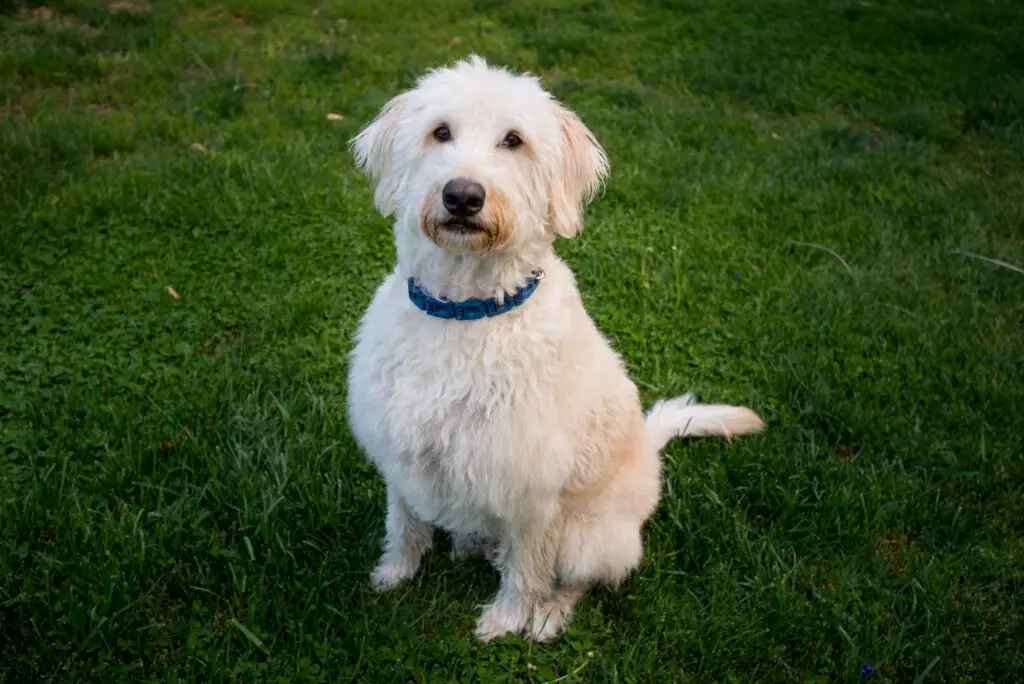Our website is supported by our users. We sometimes earn money when you click an affiliate link and make a purchase. This is at no extra cost to you and helps us to create quality content. Thank you for your support. For all that have shown us such wonderful support, we thank you from the bottom of our hearts!
Though they are not purebred dogs, the White Labradoodle is a popular hybrid breed that has gained immense popularity in recent years. This breed is a cross between a Labrador Retriever and a Poodle, resulting in an intelligent, loyal, and friendly dog that has become a favorite among many dog lovers.
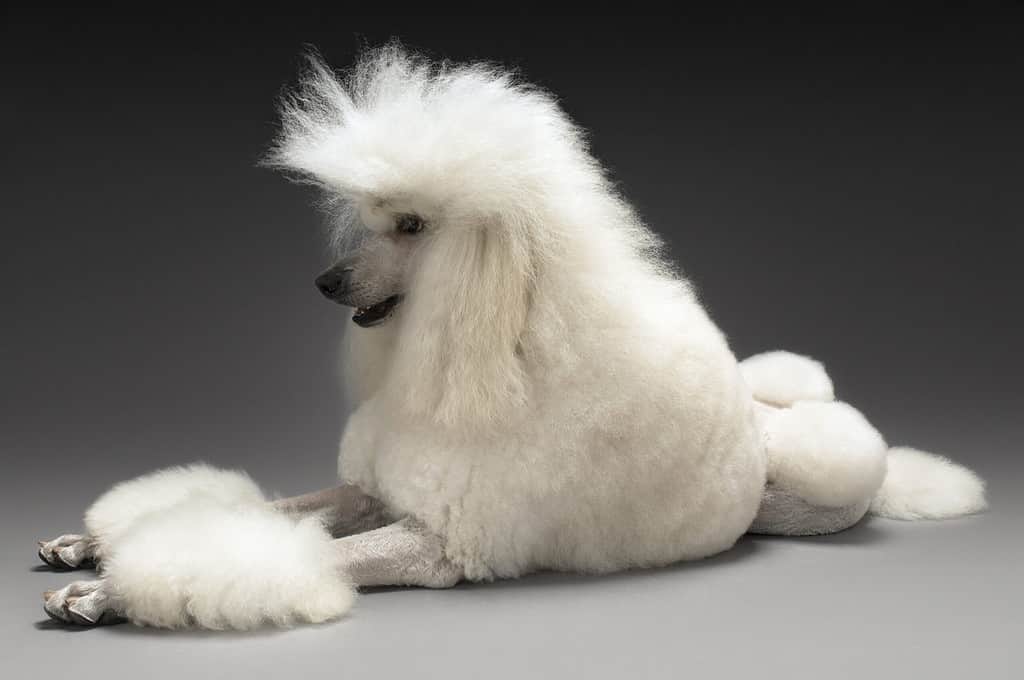
This hybrid mix is growing in popularity, you more than likely know someone who owns a doodle or have seen this designer dog. In this article, we will discuss the history, physical characteristics, temperament, training, health issues, grooming, and owning a White Labradoodle.
Though all “Doodles” are one of the cutest dog breeds sought out by dog owners for many reasons. However, the white Labradoodle is a designer dog that is growing in popularity in United States due to its snowy white coat solid color.
In fact, because it looks a little like a mini polar bear, it’s quite hard not to fall in love with a white Labradoodle puppy. It’s often said that white Labradoodle puppies resemble a teddy bear.
Dog breeders have designed 20 different colors for the Labradoodle common colors. Some of these color variations include: black labradoodles, chocolate labradoodles, cream labradoodles, caramel cream and apricot Labradoodles, the dark chocolate and the chocolate Labradoodle and the Golden Labradoodle.
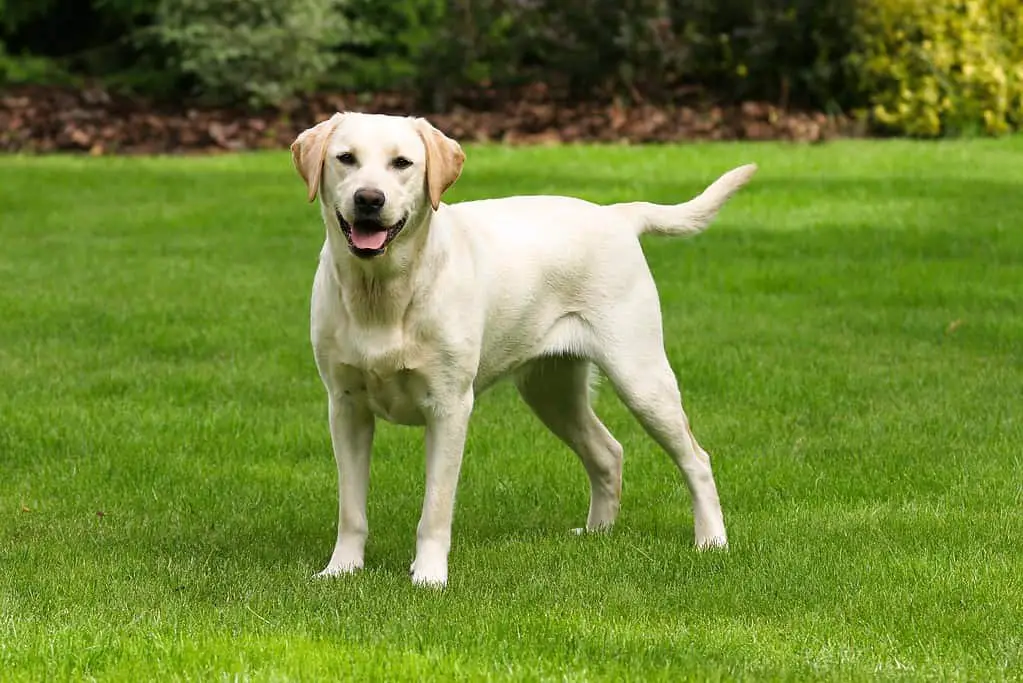
First time labradoodle owners like to know if their mix is approved by the American Kennel Club, known as the AKC. The labradoodle is considered a designer breed and not recognized by the AKC but is recognized by the Designer Kennel Club.
However, many labradoodle owners can participate in AKC events, such as scentwork, agility, flyball and Fast Cat, simply by submitting a Canine Partner application to the AKC.
History of the White Labradoodle
The origin of the Labradoodle breed can be traced back to the 1980s in Australia, where a breeder by the name of Wally Conron was tasked with creating a hypoallergenic guide dog for a visually impaired woman whose husband had allergies.
Conron’s experiment involved crossbreeding a Standard Poodle and a Labrador Retriever, and the result was a dog that had the intelligence and trainability of a Labrador Retriever, as well as the hypoallergenic coat of a Poodle.
The breed quickly gained popularity among those who needed a guide dog but were allergic to dogs with fur.
Physical Characteristics the White Labradoodle
The physical features of the white Labradoodle can vary depending on a few factors such as the parent breeds, generation, and breeder. However, there are some general characteristics that are common in most Labradoodles.
Height: White Labradoodles are usually medium to large-sized dogs. They typically stand at a height of 22 to 24 inches at the shoulder. However, some Labradoodles can be smaller or larger depending on their parent breeds and generation.
Weight: White Labradoodles usually weigh between 50 to 75 pounds. However, some may weigh more or less depending on their parent breeds and generation.
Coat Color: As the name suggests, white Labradoodles have a white color. However, some may have a creamy or light beige coat. It’s important to note that the coat color may change as the dog ages.
Coat Type: White Labradoodles have a soft and wavy coat. The coat can be either curly or straight depending on the genes inherited from the parent breeds. The coat is usually low-shedding, making it a great option for people with allergies.
Life Span: White Labradoodles have a lifespan of around 10 to 15 years, which is common for most medium to large-sized dogs.
· Average Weight Range: between 50-75 pounds
· Lifespan: between 10-15 years
· Height: medium-large dog 22-24 inches at the shoulder
· Shedding Amount: low
· Coat texture: long, medium, curly coat
· Energy levels: energetic dogs that need daily exercise
It is fascinating to know a few facts about what gives the white Labradoodle their white fur. When it comes to dog breed coat colors, they all come from two different pigments.
The first pigment is eumelanin, the dark pigment. It gives the skin, coat, and other features a dark black color. Phaeomelanin is the second pigment that determines coat color. This pigment is red and creates colors ranging from cream, gold, yellow, and apricot. The canine’s genes control the intensity of the color and in the Labradoodle this coloring comes from the red poodle.
As a white labradoodle grows, cells called melanocytes add melanin in their skin and coat. The amount of melanin that is added determines the dogs coat color. White dogs are a result of a lack of pigmentation in the coat. The eyes and mouth will still have pigmentation as well as a black nose.
White labradoodles can be confused with albino dogs. The biggest difference is albinism is a complete lack of pigmentation in the coat, pads, eyes, nose, and mouth area.
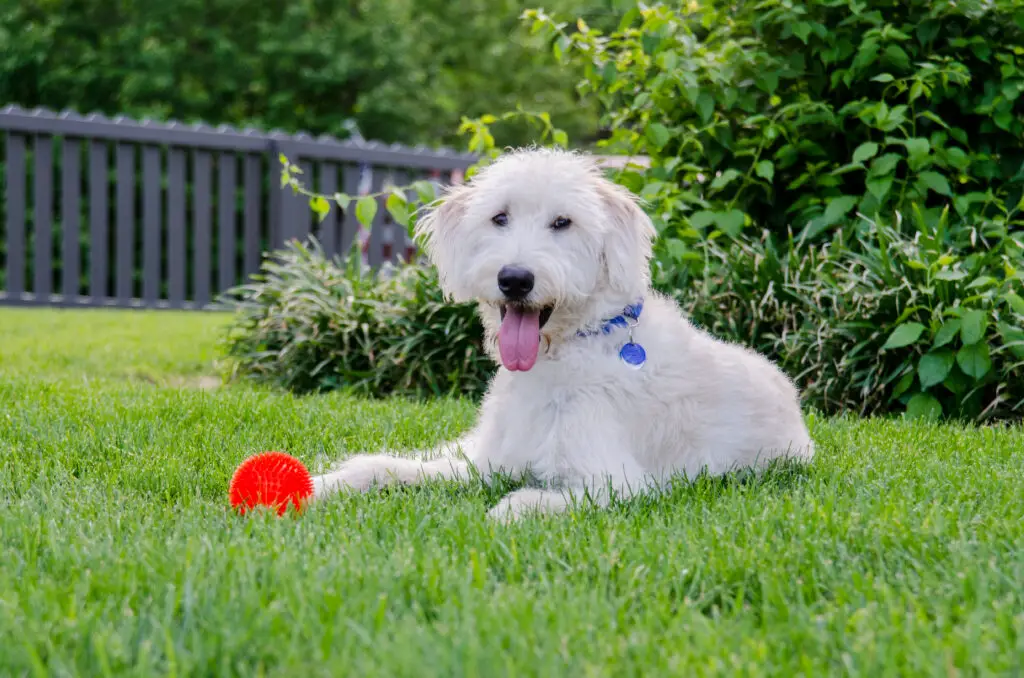
Temperament & Training of the White Labradoodle
The personality and temperament of labradoodle puppies come from both parents. One reason the American labradoodle has grown in popularity is its family friendly disposition. They are especially desirable for people that want a pet dog but are allergic to dander and fur.
The White Labradoodle can be described as an outgoing dog that is curious and likes a job. This is one reason they are trained for service dog work. Poodles bring the gentle, reserved traits, but can also be protective. Many owners say they make wonderful guardians.
In the past, both the Labrador Retriever and standard Poodle have been bred with the intention of training them for therapy work, working service dogs and even guide dog service. While poodles are known for their intelligence, they did not always make the ideal guide dog for someone without their sight for several reasons.
One big reason is the poodle is more suitable for one person or one household. Guide dogs can be in three to four homes before they are matched with a person and begin guide service.
Often the puppies begin in the home of a reputable breeder before they live with a “puppy raiser” for 12-18 months.
The final months of the dog’s training are done at guide dog training school, where the dog is trained by a professional to walk in harness and confidently guide a sightless person. Labrador Retrievers and Golden Retrievers were more forgiving and adaptable to these circumstances.
Guide dog service breeders began mixing the Labrador Retriever with a Poodle in hopes of having a guide dog that was less allergenic. Indeed, the Labradoodle sheds less and has less dander making them suitable for people with mild allergies.
The Labrador retriever brings the easy going and playful traits. They enjoy swimming, playing fetch and snuggling up with their people at the end of the day.
Both the Poodle and Labrador retriever like the water and can be trained to be excellent retrievers. Labradoodles have a natural hunting instinct, making them excellent hunting dogs. They have the eager to please trait from the Labrador retriever and the intelligence from the Poodle. Both breeds are motivated to learn and be trained.
A white Labradoodle will have plenty of energy for hiking and outdoor exploration. Owners need to be conscientious of their curly coat, as it may need attention after playing and recreating outdoors.
When it comes to temperament it is always wise to ask about both parents. The color of the coat does not affect the temperament of the dog. The exception would be if the breeders were focused more on color and made compromises when it came to the temperament of the parents.
As with all puppies, Labradoodles need adequate socialization, obedience training, daily exercise both mentally and physically and most of all the attention of the owners. The labradoodle is not a dog for the person that is gone all day every day of the week.
See our mention in Newsweek!
“Dogs are highly attuned to their environment and are able to communicate their needs and wants effectively through body language, vocalizations and other forms of communication.
“Dogs are naturally curious and love to explore their surroundings, especially when they are in a new and unfamiliar environment like camping. They may want to go outside to investigate the area, which is a positive thing as it shows that the dog is confident.”
While it’s positive when a dog is communicating to their owner, Lehr also notes that the owner has to communicate back to the dog as well.
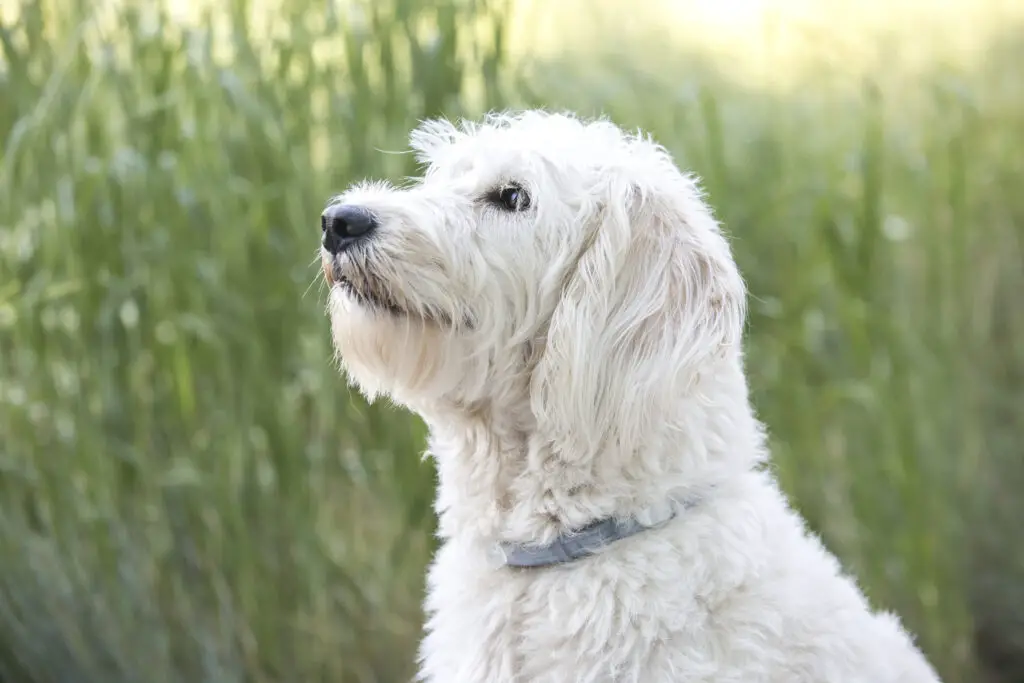
Health Issues of the White Labradoodle
The first thing you want know is the labradoodle puppies lineage and health testing results. Standard health tests done by breeders are DNA testing, heart testing, hip/elbow testing, eye/ear testing and lastly thyroid tests.
A white Labradoodle can get the best or worst traits from either the Labrador retriever or Poodle parent.
Health concerns specific to Poodles include the following:
Poodles are known for their intelligence, elegance, and hypoallergenic fur, but like all dog breeds, they are susceptible to certain health issues. To understand the potential health issues of a Labradoodle, it’s important to examine the health issues of both parent breeds.
Here are some common health issues seen in Poodles:
Addison’s Disease
Addison’s disease occurs when the adrenal glands don’t produce enough hormones, leading to lethargy, vomiting, and sometimes collapse. Poodles are more susceptible to this disease than many other breeds.
Patellar Luxation
Patellar Luxation is a common genetic disorder that affects Poodles. It is a condition where the kneecap slides out of its normal position, causing lameness and discomfort. In mild cases, rest and anti-inflammatory medication may be recommended, while more severe cases may require surgery to correct the problem.
Sebaceous Adenitis
This illness is caused by an immune system dysfunction that results in inflammation and destruction of the sebaceous glands. It is more common in Standard Poodles and may cause hair loss, dry skin, and an unpleasant odor. While there is no cure for SA, regular grooming and medicated shampoos can help manage the symptoms and prevent hair loss.
Epilepsy
Epilepsy is a neurological condition that can cause seizures. It can be genetic or caused by other factors, such as brain tumors or exposure to toxins. Poodles are prone to epilepsy.
Von Willebrand’s Disease
This is a genetic disorder that affects the blood’s ability to clot, leading to excessive bleeding. Poodles are one of the breeds that are more susceptible to this condition.
It’s important to note that not all Poodles will develop these health issues, and some may only experience mild symptoms.

Health concerns specific to Labrador Retrievers include the following:
Labrador Retrievers are generally healthy dogs, but like all breeds, they can be prone to certain health conditions. Some of the most common health issues that Labrador Retrievers face are:
Ear Infections Labrador Retrievers have floppy ears, which can trap moisture and bacteria, leading to ear infections. These infections can be painful and uncomfortable for the dog.
It is important to clean their ears once a month and properly dry them after baths and swimming. These wipes are convenient and are portable so you can clean your Labs ears after swimming in bacteria laden water or mud.
It’s important to note that not all Labrador Retrievers will develop these health issues, and there are steps you can take to reduce your dog’s risk. Regular exercise, a healthy diet, and regular veterinary check-ups can all help keep your dog healthy and reduce their risk of developing health issues.
Hereditary Myopathy
Hereditary Myopathy or muscle weakness, is a genetic condition that affects some Labrador Retrievers. This condition is also known as “exercise-induced collapse” because affected dogs will often show signs of weakness or collapse during periods of intense exercise or excitement. Hereditary myopathy is caused by a mutation in a specific gene that is responsible for the production of a protein involved in muscle function. While not all Labs with the mutation will develop muscle weakness, those that do may experience difficulty standing, walking, and breathing. There is no cure for hereditary myopathy, but affected dogs can be managed through careful exercise management and medication to control symptoms. It is important for breeders to screen their dogs for the mutation and avoid breeding affected individuals to prevent the spread of this condition in the Labrador Retriever population.
Heart Disorders
There is a possibility that Labrador retrievers have a genetic predisposition to develop various heart diseases, such as pulmonic stenosis (narrowing of the pulmonary valve), persistent arterial duct stenosis and Tricuspid Valve Displasia.
Pulmonic Stenosis
Pulmonic Stenosis is a congenital heart defect that affects some Labrador Retrievers. This condition is caused by a narrowing of the pulmonary valve, which can lead to restricted blood flow from the heart to the lungs.
Symptoms of Pulmonic Stenosis can vary, but affected dogs may experience weakness, exercise intolerance, fainting, and difficulty breathing.
Diagnosis typically involves a physical exam, electrocardiogram, and echocardiogram. Treatment may include medication to manage symptoms or surgical intervention to repair the narrowed valve.
Again, it is important for breeders to screen their dogs for this condition and avoid breeding affected individuals to prevent the spread of this defect in the Labrador Retriever population.
Persistent Arterial Duct Stenosis
Persistent arterial duct stenosis (PDA) is a congenital heart defect that can occur in some Labrador Retrievers.
This condition is caused by the failure of the ductus arteriosus, a blood vessel that connects the aorta and pulmonary artery in fetuses, to close properly after birth.
PDA can lead to restricted blood flow and increased pressure in the heart, which can cause symptoms such as coughing, exercise intolerance, and difficulty breathing.
Treatment may involve medication to manage symptoms or surgical intervention to close the PDA.
Tricuspid Valve Displasia
Tricuspid valve displasia is a common congenital heart defect that can affect Labrador Retrievers. This condition is caused by abnormal development of the tricuspid valve in vitro, which can lead to leakage of blood between the right atrium and ventricle of the heart.
Symptoms of tricuspid valve displasia (TVD) can include coughing, exercise intolerance, and difficulty breathing.
Diagnosis typically involves a physical exam, electrocardiogram, and echocardiogram. Detection of TVD is commonly found during routine checkups and can even be found in young dogs as a “murmur.”
Treatment may involve medication to manage symptoms or surgical intervention to repair or replace the damaged valve.
Health Issues for Labradoodles as a mix of both Parent Breeds
Hip and Elbow Dysplasia
These are common orthopedic conditions where the hip and elbow joints don’t develop properly. This can lead to pain, stiffness, and difficulty moving around. It can also increase the risk of arthritis.
Obesity: Labrador Retrievers are known for their love of food, which can make them prone to obesity. Obesity can lead to a range of health problems, including joint pain, heart disease, and diabetes.
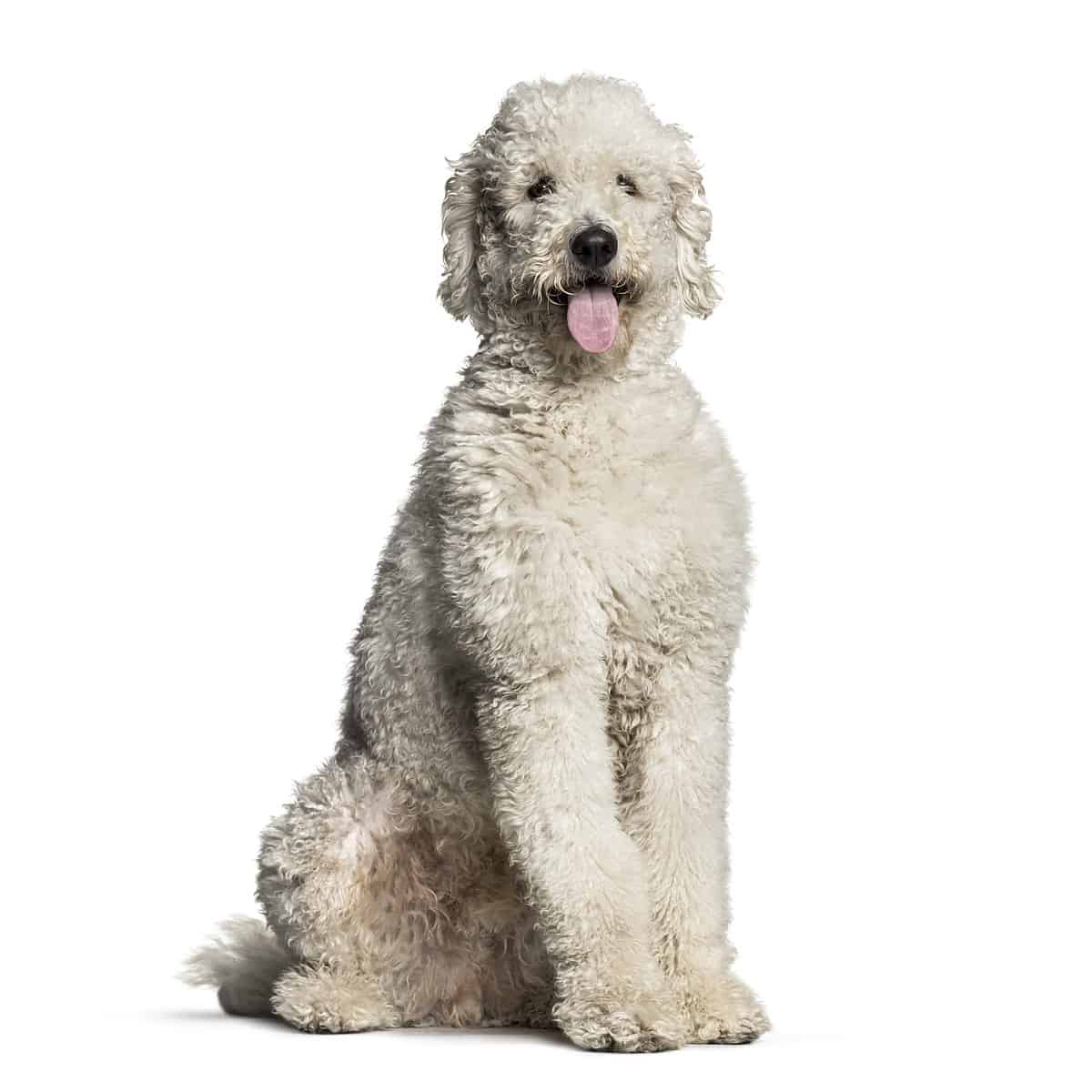
Eye Problems
Labrador Retrievers can be prone to several eye conditions, including cataracts, progressive retinal atrophy (PRA), and retinal dysplasia. These conditions can lead to vision loss and, in some cases, blindness.
Progressive Retinal Atrophy (PRA)
Though this is mentioned above, we feel it is worth explaining better.
This is a group of eye diseases that cause the gradual deterioration of the retina, leading to blindness. PRA is a hereditary condition that affects many dog breeds, including Poodles and Labs.
PRA causes the degeneration of the retina, which leads to progressive vision loss and eventual blindness.
Signs can include night blindness, dilated pupils, and a decrease in visual acuity. As the disease progresses, affected dogs may become completely blind.
In Poodles, the disorder known as PRA is likewise inherited and is brought on by a mutation in the gene that is responsible for producing the photoreceptor protein.
Progressive rod-cone degeneration (PRA-PRCD) and progressive retinal atrophy with progressive rod-cone dysplasia (PRA-CRD4) are the two most frequent kinds of PRA that affect Poodles. Both of these conditions are classified as PRA.
Poodles often begin to show signs of PRCD between the ages of 3 and 5 years of age, but PRA-CRD4 can emerge in Poodles as young as 2 years of age.
Unfortunately, there is currently cure available for PRA. However, with the right kind of care and management, dogs who are impacted by the disease can still enjoy a high quality of life.
Owners can work with their veterinarians to establish a treatment plan for their dogs that may involve environmental adaptations, such as keeping the house free of obstructions and using auditory cues to help lead the dog.
Additionally, owners can provide additional support and training to assist their dogs in adjusting to their blindness.
In addition, genetic testing can assist in the identification of dogs that are carriers as well as affected dogs, which can aid in the prevention of the progression of PRA in subsequent generations of Labrador Retrievers and Poodles.
Cancer
One health concern that plagues both parent breeds, the Labrador Retriever and the Standard Poodle is cancer. The white Labradoodle can have any mix of the health issues from either parent. Proper genetic testing and health clearances give breeders vital information before breeding. Labrador Retrievers are also prone to certain types of cancer, including bone cancer, lymphoma, and mast cell tumors.
Bloat
Bloat, also known as gastric torsion, is a potentially fatal condition in which the stomach fills with gas and twists on itself. The dog is unable to release the gas on their own.
Poodles, as well as Labradors, are a deep-chested breed, which puts them at a higher risk of developing bloat.
It is most common between the ages of 7 and 12 years and can occur without notice. Though it is not a concrete fact, is believed that one trigger for bloat is when the dog ingests large amount of food or water too quickly. Some owners use slow-feed dog bowls in order to stop their dog from eating too fast.
Skin Allergies
Both Labs and Poodles have sensitive skin, which can make them more susceptible to allergies. These allergies can cause itching, rashes, and other skin irritations.
There are shampoos that can help with skin allergies.
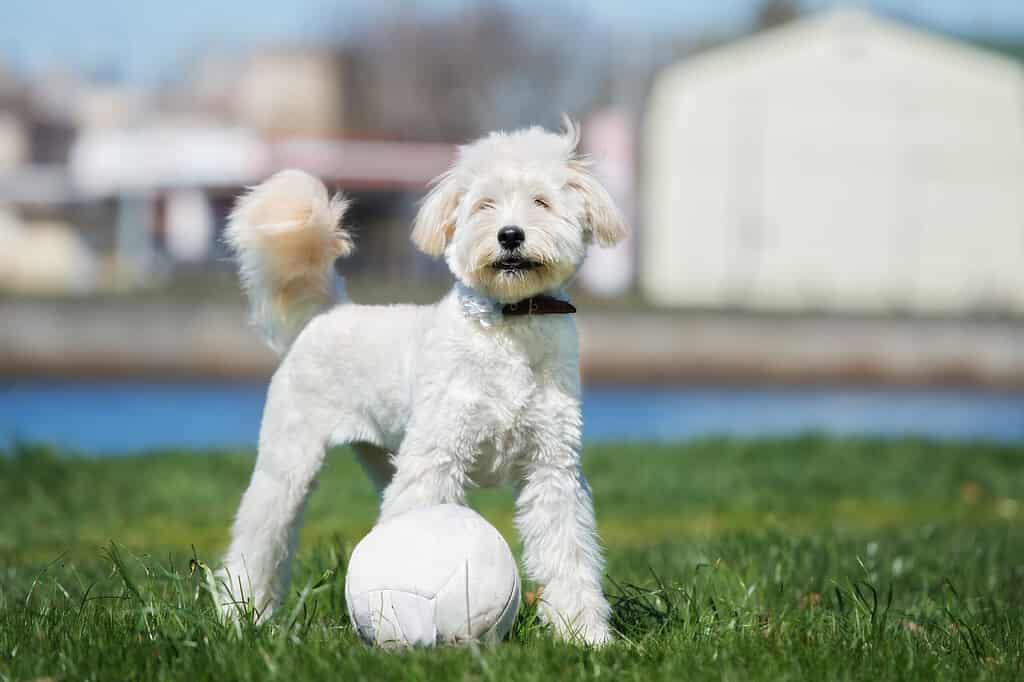
Grooming a White Labradoodle
Grooming is an essential aspect of caring for a white Labradoodle. It helps to maintain their coat’s quality, prevents matting, and reduces the risk of skin infections. Proper grooming will also help you bond with your dog and keep them looking neat and tidy.
Brushing/Combing
White Labradoodles require regular brushing to keep their coats clean and free of mats. Brushing should be done at least once a week, or more frequently if the dog is shedding excessively. A slicker brush is the best type of brush for a Labradoodle’s coat, as it can easily remove mats and tangles. Start brushing from the head and work your way down to the tail, being careful not to pull too hard on any mats.
Bathing
Bathing a white Labradoodle should be done as needed, but not too frequently. Too much bathing can strip their coat of natural oils and dry out their skin. When bathing your dog, use a gentle, hypoallergenic shampoo and conditioner specifically formulated for dogs. And several shampoos for dogs with itchy skin. Rinse thoroughly and dry with a towel or a hair dryer set on low heat.
Cutting Fur
White Labradoodles require regular trimming to keep their coats at a manageable length. The frequency of trimming depends on the dog’s lifestyle and preference. A shorter cut is easier to maintain but requires more frequent trimming, while a longer cut may look nicer but requires more brushing and grooming. It’s best to consult with a professional groomer to determine the best cut for your dog.
These scissors are a good general scissor to use for cutting your Labradoodles fur. For trimming around the face, ears, we like these GLADOG Professional Grooming Scissors for Dogs with Safety Round Tips.
The clippers we use are oneisall Dog Shaver Clippers Low Noise Rechargeable Cordless Electric Quiet Hair Clippers. We used them on our Cocker Spaniel who has similar curly(ish) hair. Occasionally, if we were using the length guards, her fur would get caught at the sides. We just gently removed it and went on with the clipping.
Clipping or Grinding Nails
Trimming your white Labradoodle’s nails is an essential aspect of their grooming routine. Long nails can cause discomfort and pain when walking and increase the risk of injury. A general rule of thumb is to trim the nails every 2-4 weeks, depending on how fast they grow.
To trim your dog’s nails, you should use a pair of nail clippers that are sharp and snip off just the tips of each nail. Take attention not to cut into the quick, which is the pink area of the nail that contains blood vessels and nerves, when you are doing this. If you happen to cut the quick by accident, put some styptic powder or cornstarch to the wound to staunch the bleeding.
You also have the option of using a grinding tool, which will allow you to file down and shorten your dog’s nails without having to risk cutting the quick.
But first, check out our article on How to Grind Your Dog’s Nails Safely.
To find the best grinder for your dog, check out this article on choosing a grinder.
If you’re not comfortable trimming your dog’s nails, a professional groomer or veterinarian can do it for you.
Cleaning Teeth
Maintaining good oral hygiene is important for a white Labradoodle’s overall health. Tartar and plaque buildup can lead to gum disease, tooth loss, and even heart disease.
To clean your dog’s teeth, you should use a toothbrush with soft bristles and dog toothpaste, both of which are available at most pet supply stores. After placing a pea-sized amount of toothpaste on the brush, start brushing your dog’s teeth in a circular motion to remove plaque and tartar.
When you first begin brushing your dog’s teeth, start with just a few teeth at a time. As your dog grows more accustomed to the practice, you can progressively increase the number of teeth you brush at once. To maintain the overall health and cleanliness of your dog’s mouth, it is recommended that you brush their teeth at least once every day.
You can try utilizing dental treats, chews, or toys to help clean your Labradoodle’s teeth if they dislike having their teeth brushed. If this is the case, you will need to persevere.
GREENIES Original Regular Natural Dog Dental Care Chews are a popular brand of dental chews for dogs. These items include wheat and wheat gluten, both of which are known to trigger allergic reactions in some people. Wheat is present in another popular brand of dental chews, Nylabone Nutri Dent Natural Dental Chew Treats, which are also enjoyed by many customers.
Before you give any goodies to your dog, you need to be sure that you check the ingredient list. The experts have started to steer clear of goods that contain components that may not be as beneficial to the canine diet as was previously believed.
At this point in time, it is considered that potato protein and pea protein both induce unpleasant effects and may even lead to death. Because of this, it is probably a good idea to keep your dog’s contact with these components to a minimum until further information and conclusive study is available.
Cleaning Ears
Regularly cleaning your white Labradoodle’s ears can help prevent ear infections and keep them healthy. Check their ears once a week for any signs of redness, inflammation, or discharge. Use a gentle ear cleaning solution or wipes specifically designed for dogs and a cotton ball or soft cloth to clean the ear flap and canal. Avoid using cotton swabs or going too deep into the ear canal, as this can cause injury.
Your dog’s health depends on proper care. If you’re not comfortable grooming your dog yourself, seek the help of a professional groomer or veterinarian. With proper grooming and care, your white Labradoodle will be healthy, happy, and beautiful.
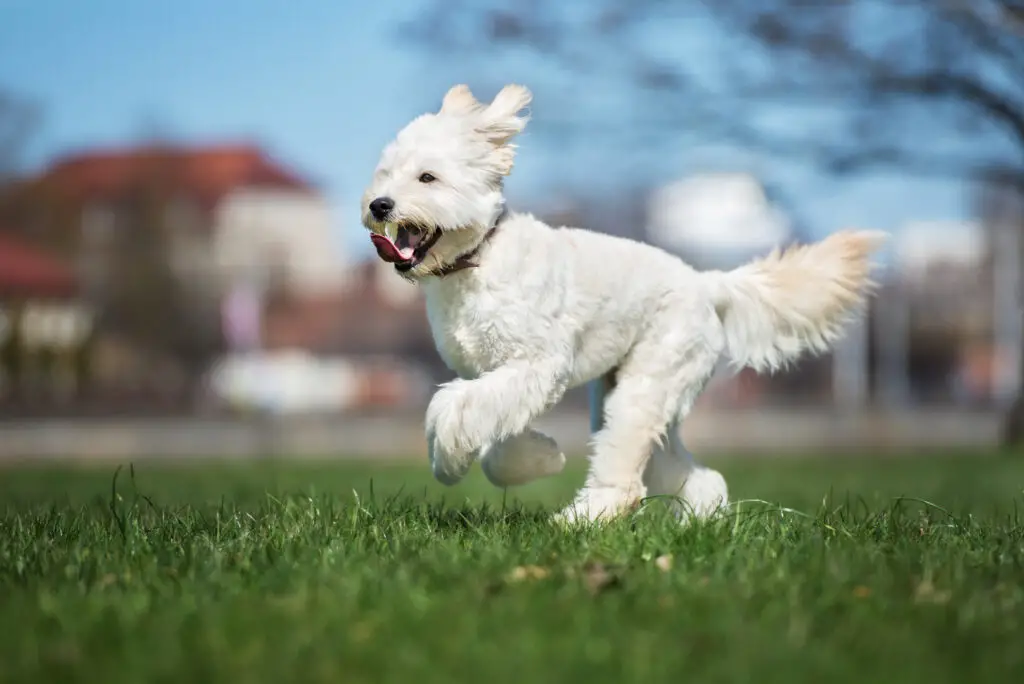
Owning a White Labradoodle
The Labradoodle is a popular breed, and owning a white Labradoodle comes with unique traits and considerations. Here are some things to keep in mind if you’re considering bringing a white Labradoodle into your home:
Special Traits
White Labradoodles are known for their intelligence, loyalty, and affectionate nature. They are highly trainable and make great family pets. Additionally, their hypoallergenic coat makes them an ideal choice for families with allergies.
Cost of Purchase
The cost of purchasing a white Labradoodle will depend on several factors, including the breeder, the dog’s lineage, and the dog’s age. On average, you can expect to pay between $1,500 to $3,500 for a White Labradoodle.
Maintenance Costs
As previously mentioned, grooming and veterinary care are essential components of owning a Labradoodle. The cost of grooming can range from $50 to $100 per session or more, depending on the complexity of the grooming. Because of the curls and heavy double-coat, many groomers refuse to groom doodles in general. So if you find one that takes your doodle be sure to tip generously.
Regular veterinary visits can cost several hundred dollars per year, depending on the dog’s overall health.
Training
Training is crucial for a Labradoodle’s overall well-being and behavior. Basic obedience training can cost between $100 to $300 for a six-week course, while more specialized training, such as therapy or service dog training, can cost upwards of $5,000.
Finding Breeders
When looking for a breeder, it’s important to research and find a reputable breeder who adheres to breeding dogs with responsible breeding practices. You can find a list of registered breeders through the American Kennel Club or the Australian Labradoodle Association of America. Beware of backyard breeders because you may get a bargain but you may not get a good dog.
Drawbacks of Owning
While White Labradoodles are generally well-behaved and affectionate pets, there are some potential drawbacks to owning one.
For instance, Labradoodles can be prone to separation anxiety, so they may not be the best fit for families who are away from home for extended periods. Additionally, their high energy levels require plenty of exercise and stimulation, so they may not be the best fit for apartment living.
Fun Fact
The White Labradoodle has become a popular breed not only for its hypoallergenic coat but also for its versatility. They have been trained as service dogs, therapy dogs, and even as search and rescue dogs.
The Bottom Line on the White Labradoodle
In conclusion, the white Labradoodle is a popular and beloved hybrid breed that combines the best traits of its parent breeds, the Labrador Retriever and the Poodle. As a relatively new breed, the history of the white Labradoodle is still evolving, but the breed has already won the hearts of many dog lovers worldwide.
One of the most notable physical characteristics of the white Labradoodle is its curly, non-shedding coat, which requires regular grooming to keep it healthy and shiny. The breed is also known for its friendly and loyal personality, making it an excellent family pet and therapy dog.
When it comes to training and temperament, the white Labradoodle is highly intelligent and trainable, and it responds well to positive reinforcement and consistent training methods. However, as with any breed, early socialization and training are crucial to prevent any behavioral issues from developing.
In terms of health issues, the white Labradoodle is generally a healthy breed, but it can be prone to some of the same health issues as its parent breeds, such as hip dysplasia, eye problems, and allergies. As such, it’s essential to choose a reputable breeder who can provide you with health clearances for both parent breeds and who practices responsible breeding practices.
Grooming is another important aspect of owning a white Labradoodle. Regular brushing and combing are necessary to prevent matting and tangling of their curly coat. Bathing should be done when necessary, and it’s recommended to use a mild, dog-specific shampoo. Fur cutting and trimming may also be necessary, depending on the owner’s preference, and regular nail clipping, teeth cleaning, and ear cleaning should be part of their grooming routine.
In terms of owning a white Labradoodle, there are some drawbacks to consider. These dogs require regular exercise and attention, and they can become anxious or destructive if left alone for long periods. Additionally, their non-shedding coat requires frequent grooming, which can be time-consuming and costly.
However, the joy and companionship that a white Labradoodle can bring to its owners make it a worthwhile investment. The breed is known for its friendly and outgoing nature, and its hypoallergenic coat makes it an excellent choice for those with allergies.
In conclusion, the white Labradoodle is a unique and lovable hybrid breed that offers the best of both worlds from its parent breeds.
While it’s important to consider the grooming needs and potential health issues associated with the breed, the white Labradoodle’s loyal and friendly temperament makes it a fantastic addition to any family. Whether you’re looking for a loyal companion, a therapy dog, or just a new furry friend, the white Labradoodle is a breed that’s sure to bring a smile to your face and warmth to your heart.
Please read our Legal Disclaimer

